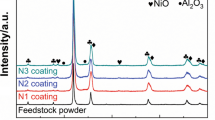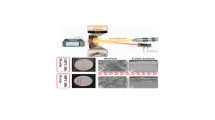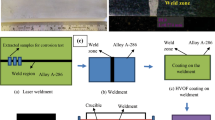Abstract
Owing to the high chemical reactivity of molten uranium alloys, the use of traditional graphite crucibles for casting fuel slugs for a sodium-cooled fast reactor (SFR) is problematic. Moreover, rare earth (RE) elements retained in the fuel slugs for an SFR, which are extracted from the spent fuel by pyro-processing, are more reactive than uranium melt. Therefore, in this study, Y2O3 single-layer coatings with thicknesses of approximately 50, 70, and 120 μm and double-layer coatings of TaC/Y2O3 and Y2O3/TaC were plasma-sprayed onto niobium substrates and tested for thermal shock resistance and compatibility against U–10 wt% Zr and U–10 wt% Zr–5 wt% RE melt. The Y2O3 single-layer coating, regardless of coating thickness, and the TaC/Y2O3 double-layer coating showed good contact at the interface between the coating and the niobium substrate, with no deterioration after the thermal cycling test. In the interaction studies, the single- and double-layer coatings showed good compatibility with the U–Zr melt. However, the Y2O3 coatings with thicknesses of approximately 50 and 70 μm showed severe penetration of the U–Zr–RE melt and reacted with the niobium substrate. The single-layer Y2O3 coating with a thickness of 120 μm and the double-layer TaC/Y2O3 coating exhibited the most promising performance among the candidate coatings.







Similar content being viewed by others
References
Condon JB, Holcombe CE (1977) Union Carbide Corp. Nuclear Div., Oak Ridge Y-12 Plant
Pfdender E (1999) Plasma Chem Plasma Process 19:1–27
Indacochea JE, Mcdeavitt S, Billings GW (2001) Adv Eng Mater 3:895–901
Li GD, Xiong X, Huang BY, Huang KL (2007) Trans Nonferrous Met Soc 18:255–261
Sclichting KW, Padture NP, Jordan EH, Gell M (2003) Mater Sci Eng, A 342:120
El-Turki A, Allen GC, Younes CM, Day JCC (2004) Mater Corros 55:24–29
Koger JW, Holcombe CE, Banker JG (1976) Thin Solid Films 39:297–303
Burkes DE, Fielding RS, Porter DL, Crawford DC, Meyer MK (2009) J Nucl Mater 389:458
Ogata T, Tsukada T (2007) Engineering-scale development of injection casting technology for metal fuel cycle, In Global 2007, Boise, pp 9–13
Author information
Authors and Affiliations
Corresponding author
Rights and permissions
About this article
Cite this article
Kim, J.H., Kim, H.T., Kim, K.H. et al. Interaction phenomena between ceramic coatings and liquid uranium alloys. J Radioanal Nucl Chem 300, 1245–1251 (2014). https://doi.org/10.1007/s10967-014-3086-1
Received:
Published:
Issue Date:
DOI: https://doi.org/10.1007/s10967-014-3086-1




